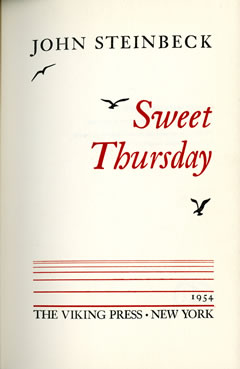Sweet Thursday
You may click on the thumbnail images to view them full screen

Steinbeck, John. Sweet Thursday. New York: Viking, 1954.
Like Tortilla Flat, Steinbeck's novel Sweet Thursday re-enacts portions of the Arthurian story in the modern world; but instead of following the tragic pattern of Malory's romance, as the earlier novel does, Sweet Thursday offers a deliberate and comic reversal of that pattern. The Arthur figure in Sweet Thursday is Doc, a biologist who makes his living gathering marine specimens and preparing them for use in research and who is essential to the health and well-being of his community. To counteract the malaise that has descended on Doc, his friends, who live in the Palace flophouse, decide to find him a wife. In this endeavour, they are led by one of the modern knights from the Palace, a man named Hazel, Doc's champion and the Lancelot figure of the book. After a disastrous attempt to get Doc together with a woman named Suzy, Hazel realizes that Suzy's pride prevents her from renewing her relationship: only if she feels that Doc needs her will she go to him. By breaking Doc's arm with a baseball bat just as he is about to set out on trip to gather much-needed marine specimens to replenish his diminished stock, Hazel forces Suzy to act. His plan works: Suzy rushes to Doc, offering to drive him on his trip and turn over rocks for him so he can find his specimens. The reversal of Malory's tragedy is complete when Doc tells Suzy of his love for her and she responds, 'Brother . . . you got yourself a girl.' Instead of the fatal wound that Malory's Arthur suffers, Doc receives a wound that gives his life meaning. Instead of having his closest companion betray him by loving his wife, Doc's friends bring him together with the woman he loves. And in another reversal, the knights of the Palace Flophouse rig a raffle so that Doc wins the building in which they dwell. Therefore, instead of causing the destruction of Camelot, Doc's friends make him the possessor of the Palace.
The ending offers yet another inversion of the traditional story. Doc and Suzy depart after she, never having driven before, gets a quick driving lesson. Steinbeck seems to be thinking of the ending of Tennyson's Idylls where Bedivere, alone on the shore, watches the barge carrying Arthur and the mystic maidens become smaller and smaller until it disappears into the light of the dawn. Steinbeck's departure scene suggests the different tone of his novel: 'Doc turned in the seat and looked back. The disappearing sun shone on his laughing face, his gay and eager face. With his left hand he held the bucking steering wheel.' Doc, wounded but joyful, sets out towards the water—never mind that they are heading for La Jolla rather than Avalon—with Suzy driving the car for their festive rather than funereal trip.